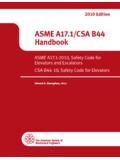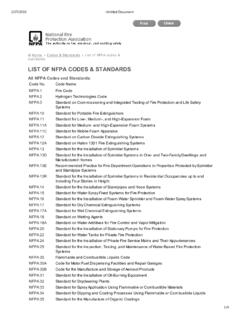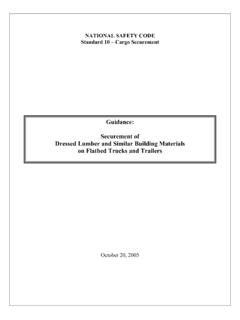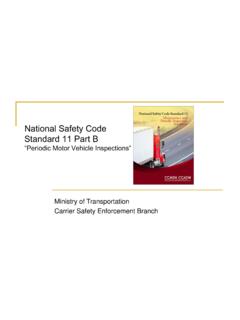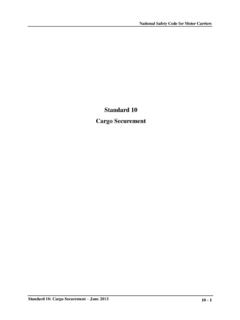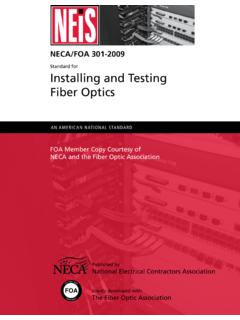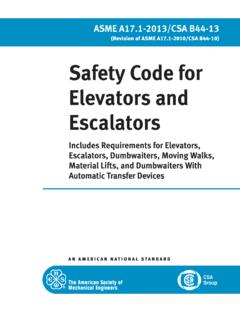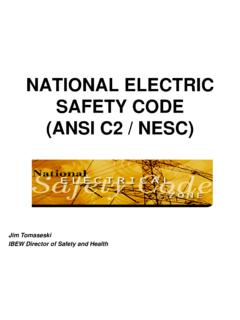Transcription of National Safety Code Standard 10 – Cargo Securement ...
1 SUMMARY INFORMATION National Safety code Standard 10 Cargo Securement Changes Effective January 1, 2010 Requirement to use tiedowns marked with Working Load Limit Requirement to use automatic tiedown tensioning devices for Securement of logs loaded crosswise Updated December 2, 2010 Rating and Marking of Tiedown Strength (NSC 10 - Part 1, Division 3, Section 11 (4)) Issue: National Safety code Standard 10 Part 1, Division 3, Section 11 (4) states: On and after January 1, 2010, a person shall not use a tiedown or a component of a tiedown to secure Cargo to a vehicle unless it is marked by the manufacturer with respect to its working load limit. Background The provision to require the strength (Working Load Limit) of tiedowns to be provided by the manufacturer and marked on the tiedown assembly was developed with, and supported by, industry stakeholders during preparation of the North American Cargo Securement Standard from 1994 to 1999.
2 In these discussions it was agreed that an orderly implementation of this requirement could be accommodated with 5 years notice, based on the typical service life of commonly used tiedown assemblies. NSC Standard 10 was approved by the Council of Ministers Responsible for Transportation and Highway Safety in September 2004, and was implemented by Canadian provinces and territories by mid 2005. The requirement to use rated and marked tiedowns will affect carriers and shippers in Canada and the United States who use tiedowns to secure Cargo particularly those who use flatbed trucks and trailers. Transition and Educational Period Implementation of the requirement to use tiedowns which are rated and marked with a Working Load Limit will be phased in over a twelve month period ending on December 31, 2010 From January 1 to December 31 2010 verbal direction and/or written warnings will be issued to raise awareness of the requirement to use rated and marked tiedowns (Note: during the transition period, use of unrated/unmarked tiedowns will not preclude issuance of a CVSA decal).
3 During the transition period, violations will be recorded in situations where improper or inadequate use of the required minimum number of tiedowns (either marked or unmarked) for Securement of Cargo poses a Safety risk. During this period unmarked tiedowns will continue to be assigned default Working Load Limits from the tables which appear in NSC Standard 10. Using a tiedown or a component of a tiedown not marked by the manufacturer with respect to its Working Load Limit will not result in Out-of-Service unless a significant Safety risk is created. Default values for Working Load Limits will be eliminated from NSC Standard 10 on January 1, 2011. On and after January 1, 2011, each of the minimum number of tiedowns required under NSC 10 must be rated and marked with a Working Load Limit. Implementation Full compliance with the provisions of NSC Standard 10 Division 3 Section 11 (4) will be required and enforced on January 1, 2011.
4 Rating and Marking of Tiedown Assemblies Frequently Asked Questions 1. Is there a requirement for the manufacturers of trailers to rate the tracks that winches are mounted on? No, there is currently no requirement to rate and mark the strength of anchor points. 2. If a tiedown is made up of a strap, winch and chain, do all three pieces require a rating? If the manufacturer has provided a Working Load Limit for the complete tiedown assembly, it is not necessary to provide strength ratings for individual components which are permanent parts of the assembly. 3. Some ratings on winches are on the inside, if all three pieces are required to be rated, will inspectors require the tiedown to be taken off the load to see the rating on the winches? Not for winches that serve as anchor points and are attached to the trailer, or where a strength rating is provided for the complete tiedown assembly. 4. What information is required for marking the WLL of tiedown assemblies?
5 (eg name of manufacturer, date etc) A tiedown or a component of a tiedown should be marked in accordance with the appropriate Standard referred to in Part 4 of NSC Standard 10. 5. Can ratings only be provided by manufacturers? Yes, recognizing that a manufacturer would include individuals or companies that assemble tiedowns using components fabricated and sold by others. 6. What are the requirements for establishing the strength rating of a tiedown? The Working Load Limit of a tiedown or a component of a tiedown should be established in accordance with the appropriate Standard referred to in Part 4 of NSC Standard 10 7. Do bungee cords need to be rated and marked with a WLL? Bungee cords and tarp straps are not suitable for use as tiedowns, and are equally unsuited to having an assigned Working Load Limit. There is no intention to prohibit the use of these devices as supplementary restraint for light weight Cargo and equipment.
6 8. What are the requirements for rating and marking the strength of rope tiedowns? A rope tiedown should be rated and marked in accordance with the appropriate Standard referred to in Part 4 of NSC Standard 10. 9. Are knots permitted in ropes used as tiedowns? A rope tiedown should be used in accordance with the provisions of the appropriate Standard referred to in Part 4 of NSC Standard 10, including any restrictions on the use, or presence, of knots. 10. Do devices used in conjunction with a securing device to prevent a tiedown from becoming loose, unfastening, opening or releasing while the vehicle is in transit require a WLL marking (eg. metal rod on load binder). No. 11. Do the markings need to be a numeric marking or will a manufacture code be sufficient? Marking of Working Load Limits should be in accordance with the provisions of the appropriate Standard referred to in Part 4 of NSC Standard 10. 12. Is there a durability requirement for marking by the manufacturer with respect to its working load limit?
7 No, but the absence of a legible marking from the manufacturer indicating the strength of a tiedown will cause it to be assigned a default WLL of zero. Securement of Shortwood Loaded Crosswise Automatic Tensioning Devices (NSC 10 - Part 2, Division 1, Sections 35 (2) and 36(2)) Issue: National Safety code Standard 10 Part 2, Division 1, Sections 35(2) and 36(2) state: A vehicle built on or after January 1, 2010 shall be equipped with a device that maintains a tension not less than 900 kg at all times, and automatically takes up slack in the tiedown as the logs settle. Background: NSC Standard 10 requires the use of longitudinal tiedowns to secure stacks of shortwood loaded crosswise on vehicles: - At least two tiedowns for a single stack - At least one tiedown per stack if two stacks are loaded side by side on a vehicle Single Stack Two Stacks Automatic tensioning devices have been in usage on some of these configurations for several years.
8 These systems typically use an air or mechanical spring to apply tension to the tiedowns, usually through lever or pulley based equalization system: The use of tension equalization mechanisms as shown above results in the ends of both tiedowns being connected together at a common point. Consequently, failure of either tiedown will result in loss of tension in both. In addition, it could be argued that the requirement for at least two tiedowns on a single Tiedowns Tiedowns Tensioning Spring Tensioning Spring Tiedowns stack of shortwood is not met (by the definition of a tiedown), as linking two tiedowns through a pulley effectively results in a single tiedown. Nationally acceptable automatic tensioning devices mechanisms must include supplementary Safety chains or cables, as depicted below. This will ensure that some level of tension is maintained in one of the tiedowns in the event of failure of a single tiedown or the tensioning device.
9 Implementation Full compliance with the provisions of NSC Standard 10 Part 2, Division 1, Sections 35(2) and 36(2) will be required and enforced on January 1, 2010. Tensioning Spring Tiedowns Safety Cable Pulley
